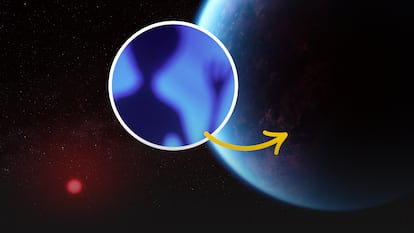Habitable ocean planets: signs of extraterrestrial life?

In April of this year, a team of astronomers led by Nikku Madhusudhan announced the possible detection of life on the exoplanet K2-18b, more than 120 light-years from Earth. A faint trace of dimethyl sulfide was found in the atmosphere of that ocean-covered world. On our planet, this compound only produces living organisms, primarily marine microbes.
At a press conference, Madhsusudhan claimed there was only a three-in-a-thousand chance that this could have something other than extraterrestrial life, but his fellow scientists disagreed and spent several weeks conducting experiments to spoil his party.
The search for extraterrestrial life on oceanic worlds like K2-18b, which are abundant in the universe, would broaden the spectrum of habitable planets, but more evidence is needed to ensure they can support living beings.

Daniel Mediavilla is the co-founder of Materia, the science section of EL PAÍS. He previously worked at ABC and Público. As a break from journalism, he has written speeches. He is interested in the power of science and, increasingly, its limits.
EL PAÍS



%3Aformat(jpg)%3Aquality(99)%3Awatermark(f.elconfidencial.com%2Ffile%2Fbae%2Feea%2Ffde%2Fbaeeeafde1b3229287b0c008f7602058.png%2C0%2C275%2C1)%2Ff.elconfidencial.com%2Foriginal%2F6f5%2Fa5a%2Ffb5%2F6f5a5afb54487ac8cd06f1b01d416f73.jpg&w=1280&q=100)
%3Aformat(jpg)%3Aquality(99)%3Awatermark(f.elconfidencial.com%2Ffile%2Fbae%2Feea%2Ffde%2Fbaeeeafde1b3229287b0c008f7602058.png%2C0%2C275%2C1)%2Ff.elconfidencial.com%2Foriginal%2F113%2F965%2F784%2F113965784fc71a2a6c76b8b3059cd301.jpg&w=1280&q=100)

%3Aformat(jpg)%3Aquality(99)%3Awatermark(f.elconfidencial.com%2Ffile%2Fbae%2Feea%2Ffde%2Fbaeeeafde1b3229287b0c008f7602058.png%2C0%2C275%2C1)%2Ff.elconfidencial.com%2Foriginal%2F9b7%2F417%2Fb0e%2F9b7417b0e1278a5ca815a57b13052dee.jpg&w=1280&q=100)